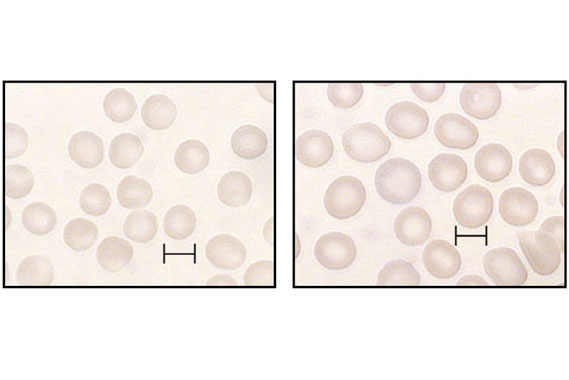
Regulatory RNA: The sculptors of gene expression
This story is part of our series, Looking Beyond the Gene. Click here to see all stories in this collection.
In the late 1950s, Francis Crick proposed his “central dogma”: DNA begets RNA, RNA begets protein, and protein cannot transfer information back to DNA or RNA. But as scientists have been able to explore more deeply how the DNA sequence of our genes are read or “transcribed” into RNAs called messenger RNAs (mRNAs), and those mRNAs are ultimately translated into proteins, the mechanisms regulating gene expression have gotten, well, complicated. Some proteins effectively barricade certain genes, blocking access and making them difficult to transcribe, while other proteins can remodel the final protein products. Added into this mix are different types of RNAs that attenuate or enhance gene expression. Scientists at Whitehead Institute and around the world have uncovered hundreds of these “regulatory RNAs” and many more RNAs that might also have regulatory functions. Collectively their research shows that frequently it is regulatory RNAs’ influence that determines whether or how a gene’s DNA sequence ends up as a viable protein.
The DNA sequences that encode most regulatory RNAs reside in what researchers once dismissed as genomic dead weight — the more than 97% of the human genome that is considered “noncoding” DNA because it does not produce mRNA templates for proteins. Tools and methods developed over the past thirty years have revealed within this “junk DNA” a panoply of critical elements that include sequences encoding regulatory RNAs, such as microRNAs (miRNAs) that tune protein production and long noncoding RNAs (lncRNAs), some of which can also alter gene transcription.
Modifying protein production is not limited to noncoding RNAs. In some cases mRNAs can even influence the proteins created from them. By folding into different shapes, certain mRNAs can alter their fate to produce templates for two, three, even one hundred different proteins.
From their work characterizing some of the first miRNAs and lncRNAs, to connecting RNA form to function, Whitehead Institute scientists have been at the forefront of discovering the many ways that RNAs can regulate gene expression. Their foundational work has transformed researchers’ understanding of gene regulation and revealed a complex, elegant, and highly responsive system that tailors gene expression for each cell type and tissue.
miRNAs: Redefining gene regulation and spawning a new avenue for therapeutics
At only 22 base pairs long, miRNAs may be small, but their effects resonate throughout evolution and development in both plants and animals. Whitehead Institute Member David Bartel likens miRNAs to sculptors of the transcriptome, chiseling away at gene expression to such an extent that in some cases miRNAs can trigger developmental changes. More often, miRNAs optimize gene expression, customizing it for many genes in each cell type. In many cases the role of a miRNA is so important that removing its activity in mouse studies can have dramatic effects, including death (typically before birth or soon after birth), epilepsy, deafness, infertility, and cancer.
To exert their effects, miRNAs act as guides in a gene-silencing pathway related to RNA interference (RNAi), a mechanism found in most organisms that protects the cell from invaders, such as viruses or transposons. In RNAi, a short RNA threads into a protein called Argonaute, and the RNA-Argonaute complex then pairs with an mRNA segment that matches the RNA’s sequence. The mRNA is then destroyed by the cell. By constricting the pool of available mRNA templates, RNAi decreases the amount of proteins built from those mRNAs. In animals and plants, the miRNA pathway evolved from the RNAi pathway as a way for these organisms to modify gene expression.
Soon after the phenomenon of RNAi was first reported in 1998, Bartel and his lab began working to uncover this intriguing mechanism. Ever since, he has been at the forefront of the miRNA field: He was the first to identify miRNAs in plants and one of three labs to first recognize the abundance of miRNAs in animals. Bartel’s research has deciphered many of RNAi’s effects at the organismal and molecular level, including implicating miRNAs as regulating the production of most human proteins.
 |
| Read more: On Target |
Building on his research that deciphered many of the mechanics underpinning the functions of miRNAs, Bartel established a methodology that can predict a miRNA’s regulatory targets — one miRNA can affect the expression of many genes, which can complicate researchers’ efforts in discerning its role. In order to pinpoint the mRNAs that are most influenced by each miRNA, Bartel used his target forecasting methodology to create TargetScan, the main tool that scientists use to predict miRNA targets in the genome of humans and other organisms commonly used in research. With TargetScan’s list of an miRNA’s likely targets, researchers are better able to determine its function and place it within the context of a broader network of gene control.
In the late 1990s and early 2000s, Bartel and other scientists harnessed RNAi’s capabilities into a tool for experimentally altering protein production and transformed how researchers investigate protein function. Now scientists can use miRNA-like RNAs to eliminate the mRNA encoding a specific protein to “knock down” that protein and its function. Based on what happens when that protein is reduced, scientists can then analyze the resulting effects to deduce its role. These discoveries made at Whitehead Institute have also enabled the development of a new way to treat some diseases. In many disorders, the activity of specific proteins contribute to disease pathology. Using RNAi to curb the production of those proteins, scientists and biotechnology companies are striving to create novel therapies for viral infections, neurological diseases, blood disorders, and high cholesterol.
Introns: “Discarded” RNA regulates a stress response
 |
| Read more: Revising the textbook on introns |
Nestled between the sections of an mRNA that ultimately encode a protein, introns are excised shortly after transcription. Like footage spliced from a film, introns were thought to end up on the cellular “cutting room floor” and discarded. But with the help of Whitehead Institute Founding Member Gerald Fink, Jeffrey Morgan, a former graduate student in the Bartel lab identified a group of introns in baker’s yeast that are redirected from the dustbin when the yeast population becomes too crowded for its environment. The researchers discovered that these introns constitute a previously unknown branch of the well-studied TORC1 signaling pathway, that helps control cell growth during periods of stress. When activated by yeast overgrowth, the branch seems to help the cells cope with more challenging conditions.
lncRNA: Defining an unfamiliar class of regulators
lncRNAs have recently piqued scientists’ interest as important regulators of gene expression. First identified in the 1980s, these 200-nucleotide long RNAs are found in plants and animals and play roles in proliferation, cell survival, and genomic stability.
Unlike protein-coding genes, which are frequently well-conserved between species, lncRNA genes typically have only a very small bit of conserved sequence, if any. This lack of conservation has hampered scientists’ efforts to identify associated lncRNAs in closely related species and made this task even less likely in distantly related species. But by comparing thousands of known mouse and human lncRNAs to more than 500 lncRNAs that they identified zebrafish, Bartel and Whitehead Institute Member Hazel Sive have identified 30 miRNAs that are conserved from zebrafish to mice and humans.
 |
| Read more: Long non-coding RNA prevents the death of maturing red blood cells |
lncRNAs can also play critical roles in the development of traits specific to particular cell types, as Whitehead Institute Founding Member Harvey Lodish and his lab have discovered in red blood cells and fat cells. Wenqian Hu, a postdoctoral researcher in the Lodish lab, identified a lncRNA in mice that protects red blood cells from programmed cell death during the last step of red blood cell differentiation. Excessive amounts of this lncRNA could contribute to certain types of leukemias, which can be caused by inhibition of cell death.
Juan Alvarez-Dominguez, a former graduate student in the Lodish lab, identified an additional lncRNA that plays a critical role in red blood cell differentiation. This lncRNA, called Bloodlinc, fosters the growth and development of immature red blood cells by interacting with critical regulators of their development, the proteins that support and organize DNA, and proteins called transcription cofactors that modify gene expression.
In another line of study, Alvarez-Dominguez identified more than 1000 lncRNA genes involved in regulating in mice the maturation of white fat and brown fat, a type of fat that creates heat by burning energy instead of storing energy as fat droplets like in white fat. Due to its consumption of energy, brown fat could be protective against obesity and scientists are eager to learn how to stimulate its growth. Of the lncRNAs detected by Alvarez-Dominguez, more than 100 contribute to brown fat development, and one in particular, called lncBATE1, establishes and maintains the identity of brown fat cells and ensures their ability to burn energy.
The sum is greater than the parts
 |
| Read more: Network of diverse noncoding RNAs acts in the brain |
Scientists may classify RNAs such as miRNAs and lncRNAs by length, but noncoding RNAs themselves recognize no such boundaries when they interact with each other. Case in point is a highly conserved network of noncoding RNAs acting in the mammalian brain that was identified by Ben Kleaveland, a postdoctoral researcher in Bartel’s lab. While gene regulatory networks are well described, this was the first documented regulatory network comprised of three types of noncoding RNA: two miRNAs, a lncRNA, and a circular RNA. The network’s precise function still eludes researchers, but all four components of the network are conserved throughout mammalian species and enriched in the brain, particularly in neurons, suggesting that the network may be important in brain function.
When RNA function follows form
Regulation by RNAs is not limited to noncoding RNAs. Whitehead Institute Fellow Silvia Rouskin is teasing apart how RNAs folds in cells, how those structures can regulate their expression in healthy cells, and how misfolded RNAs may be involved in diseases such as neurodegeneration and cancer. Rouskin and her lab study the human immunodeficiencey virus (HIV), the virus that causes AIDS. Using its nine-gene-encoding RNA genome, HIV can hijack an entire human cell, forcing it to make thousands of copies of the virus and ultimately cause the host cell’s demise. Although many aspects of HIV have been well-researched, little is known about how the virus can make all of the proteins necessary for productive infection from the same starting RNA molecule.
Rouskin’s work indicates that the RNA itself may regulate which proteins are produced from it. According to Rouskin, after the virus’s integrated genome is transcribed into RNA, the RNA folds into several distinct shapes. By exposing or hiding certain signals on the its surface, the RNA can control how the host’s cellular machinery processes the RNA and which of the nine genes are expressed form it. HIV’s success at utilizing one RNA with multiple shapes to create distinct proteins may not be isolated. Related research indicates that a similar mechanism may affect gene expression in the human brain.
As Rouskin, Bartel, Fink, Lodish, Sive, and others at Whitehead Institute tease apart RNA-based mechanisms regulating gene expression, their work continues to transform our perceptions of RNA’s role in gene control. No longer relegated to acting as a template for translation, RNAs, such as miRNA, lncRNA, and even folded nascent RNA, are now recognized for actively creating bespoke gene expression profiles for specific cells and tissues. By applying emerging RNA-centric tools and methods, Whitehead Institute scientists may identify as-yet undiscovered types of regulatory RNA and increase our appreciation for this crucial molecule in what may be the golden age of RNA research.
Contact
Communications and Public Affairs
Phone: 617-452-4630
Email: newsroom@wi.mit.edu


